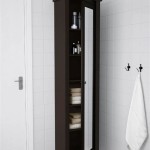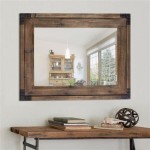Should You Use Wire To Hang A Heavy Mirror?
Hanging a mirror, particularly a heavy one, demands careful consideration of the appropriate hardware and methods. The primary goal is to ensure the mirror is securely mounted and remains stable, preventing potential damage to the mirror itself, the wall, and, most importantly, avoiding any risk of injury. One common question that arises during this process is whether wire is a suitable option for hanging a heavy mirror. This article will delve into the factors that determine the suitability of using wire for this purpose, taking into account the weight of the mirror, the type of wall, and alternative hanging solutions.
The inherent fragility of glass, coupled with the weight of the frame and backing materials, means that hanging a heavy mirror requires a robust and reliable support system. Incorrect hanging methods can lead to several problems. The mirror could detach from the wall, resulting in breakage. Furthermore, the falling mirror poses a significant safety hazard to anyone nearby. Selecting the right hanging hardware and properly installing it are essential steps in mitigating these risks.
Assessing the Weight and Size of the Mirror
The first, and perhaps most crucial, step is to accurately determine the weight of the mirror. This information is often available from the manufacturer or retailer. If the weight is unknown, it can be estimated by using a bathroom scale. Weighing oneself and then weighing oneself holding the mirror will give you the difference, which is the mirror's weight. This weight will be the primary factor in determining the appropriate hanging method. A lightweight mirror, typically under 10 pounds, might be hung with lighter-duty hardware, while a heavier mirror requires more substantial support.
The size of the mirror is also a critical factor. Larger mirrors tend to be heavier, but even if a large mirror is relatively light, its size can create leverage that puts extra strain on the hanging system. This leverage increases the risk of the mirror pulling away from the wall. Therefore, both weight and size must be considered together when making decisions about hanging hardware.
When considering wire as a hanging solution, its load-bearing capacity is paramount. The wire must be able to safely support the mirror's weight with a significant margin of safety. This margin accounts for any potential weakening of the wire over time due to corrosion or stress. If the wire is not strong enough, it will eventually fail, leading to the mirror falling.
Evaluating Wall Type and Hanging Options
The type of wall onto which the mirror will be hung is another critical consideration. Different wall types offer varying degrees of support. Drywall, commonly found in residential homes, is relatively weak and requires specialized anchors to support heavy objects. Plaster walls can be more durable than drywall, but they can also be brittle and prone to cracking if not handled carefully. Concrete or brick walls offer the most robust support, but they require specialized drilling and anchoring techniques.
For drywall, using hollow wall anchors, toggle bolts, or molly bolts is essential. These anchors expand behind the drywall, providing a secure hold. The weight rating of the anchors must exceed the weight of the mirror. It is always advisable to use anchors with a significantly higher weight rating than the mirror's actual weight to ensure a safety margin. Locating a wall stud is also highly recommended. Screwing directly into a stud provides the strongest possible hold, as the stud is a solid piece of wood that can bear a substantial load.
If hanging a mirror on a plaster wall, it is essential to avoid cracking the plaster. Pre-drilling pilot holes is crucial, and using appropriate anchors, such as plaster screws or expansion anchors, will help distribute the weight and prevent damage to the wall. For concrete or brick walls, a hammer drill is required to create pilot holes, and masonry screws or anchors are necessary to provide a secure hold. These screws and anchors are specifically designed to grip the hard surface of concrete or brick.
When wire is chosen as the hanging mechanism, its attachment to the wall becomes a critical point. The wire itself might be strong enough to hold the weight, but if the anchor points in the wall are weak, the entire system will fail. Therefore, selecting appropriate anchors that are compatible with both the wall type and the wire is essential.
Alternatives to Wire for Hanging Heavy Mirrors
While wire is a common option for hanging pictures and lighter mirrors, several alternative hanging solutions are more appropriate for heavy mirrors. These alternatives provide greater stability and security, reducing the risk of the mirror falling.
One popular alternative is using D-rings and heavy-duty picture hooks. D-rings are metal loops that are attached to the back of the mirror frame. These rings are then hung on sturdy picture hooks that are anchored to the wall. The picture hooks should have a weight rating that significantly exceeds the mirror's weight. Multiple D-rings can be used to distribute the weight more evenly across the frame, providing additional support.
Another robust option is using a French cleat system. A French cleat consists of two interlocking pieces of wood or metal. One piece is attached to the back of the mirror, and the other is attached to the wall. The angled design of the cleats allows them to interlock, providing a strong and secure connection. French cleats are particularly effective for hanging heavy mirrors because they distribute the weight evenly across a large area of the wall.
Z-bar clips are another alternative. These clips are metal brackets that attach to the top and bottom edges of the mirror frame and then screw into the wall. They offer a secure and discreet way to hang mirrors, as they are mostly hidden from view. Z-bar clips are especially useful for mirrors that are flush with the wall.
For very heavy mirrors, consider professional installation. Professional installers have the expertise and tools to safely and securely hang large and heavy mirrors. They can assess the wall type, determine the appropriate hanging hardware, and ensure that the mirror is properly installed. While professional installation may incur an additional cost, it can provide peace of mind knowing that the mirror is securely hung and the risk of damage or injury is minimized.
Ultimately, the decision of whether to use wire to hang a heavy mirror depends on a careful assessment of the mirror's weight, the wall type, and the availability of alternative hanging solutions. While wire might be suitable for lighter mirrors, heavier mirrors typically require more robust and secure hanging methods. Prioritizing safety and stability is paramount when hanging any heavy object, and selecting the appropriate hardware and installation techniques is crucial for a successful and long-lasting result.
How To Hang A Heavy Mirror On Drywall Without Damaging It Or The Wall Quora

How To Hang A Heavy Mirror With Pictures Wikihow

How To Hang A Mirror With Wire Pictures Wikihow

How To Hang A Mirror With Wire Pictures Wikihow

How To Hang A Heavy Mirror Or Picture True Value

How To Hang A Mirror With Wire Pictures Wikihow

How To Hang A Heavy Mirror With Pictures Wikihow

Foolproof Hang Art Or Mirror With 2 Hole Hangers Porch Daydreamer

How To Hang A Heavy Mirror The Home Depot

Picture Wire Strung Between Two D Rings Attached To The Back Of A Frame Hanging Mirror Heavy Installation








